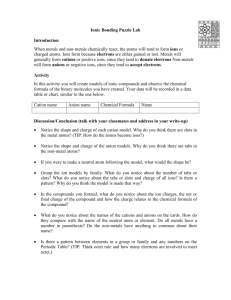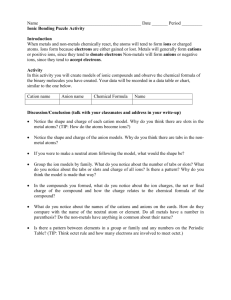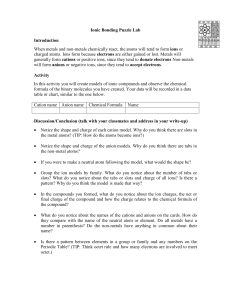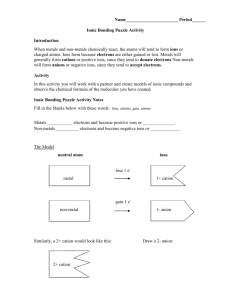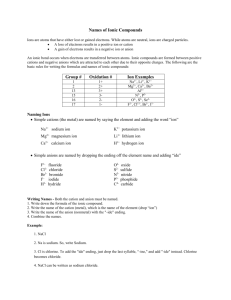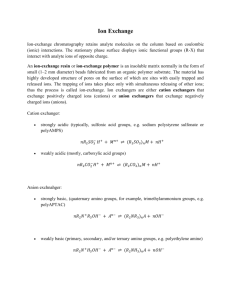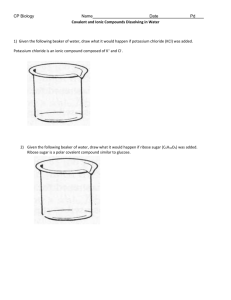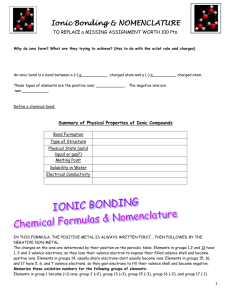Ionic Bonding Model Cards
advertisement
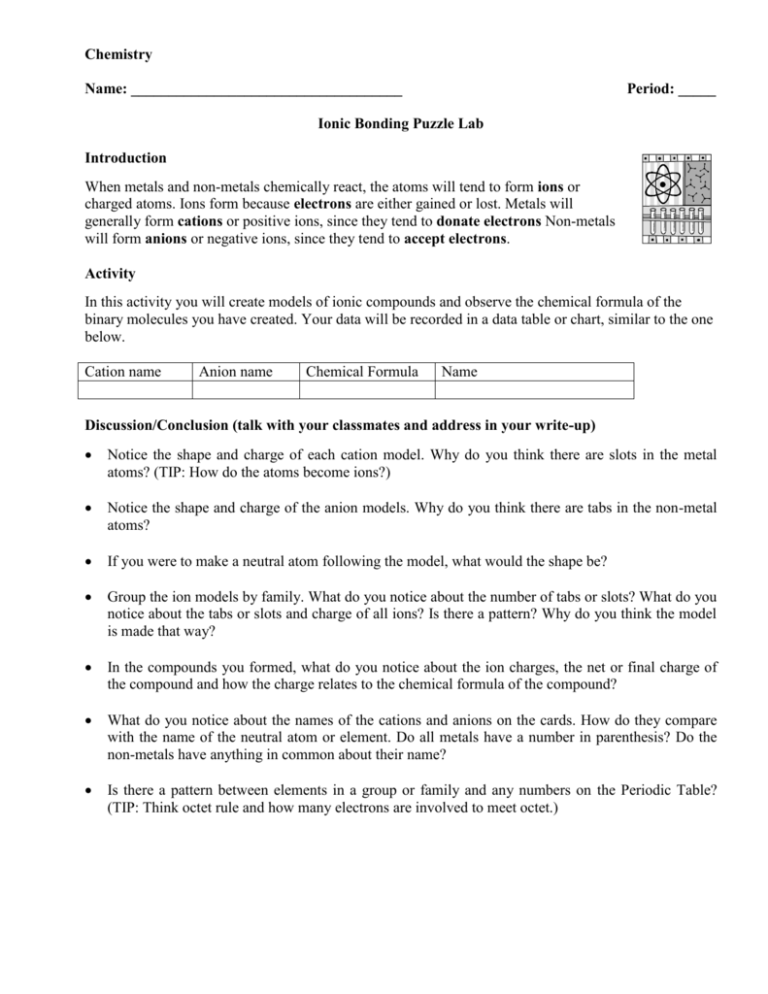
Chemistry Name: ____________________________________ Period: _____ Ionic Bonding Puzzle Lab Introduction When metals and non-metals chemically react, the atoms will tend to form ions or charged atoms. Ions form because electrons are either gained or lost. Metals will generally form cations or positive ions, since they tend to donate electrons Non-metals will form anions or negative ions, since they tend to accept electrons. Activity In this activity you will create models of ionic compounds and observe the chemical formula of the binary molecules you have created. Your data will be recorded in a data table or chart, similar to the one below. Cation name Anion name Chemical Formula Name Discussion/Conclusion (talk with your classmates and address in your write-up) Notice the shape and charge of each cation model. Why do you think there are slots in the metal atoms? (TIP: How do the atoms become ions?) Notice the shape and charge of the anion models. Why do you think there are tabs in the non-metal atoms? If you were to make a neutral atom following the model, what would the shape be? Group the ion models by family. What do you notice about the number of tabs or slots? What do you notice about the tabs or slots and charge of all ions? Is there a pattern? Why do you think the model is made that way? In the compounds you formed, what do you notice about the ion charges, the net or final charge of the compound and how the charge relates to the chemical formula of the compound? What do you notice about the names of the cations and anions on the cards. How do they compare with the name of the neutral atom or element. Do all metals have a number in parenthesis? Do the non-metals have anything in common about their name? Is there a pattern between elements in a group or family and any numbers on the Periodic Table? (TIP: Think octet rule and how many electrons are involved to meet octet.) Ionic Bonding Model Lab Scoring Rubric Lab format follows the expected guidelines in the handout. Blank page on left for scores, Title, Purpose, Materials, Procedure, Data table, Discussion/Conclusion. Data is organized into a table with the names of cation, anion, chemical formula and compound name. 4 Discussion and Conclusion addresses: Explain how the model relates to the ion; number and shape of slot, (ie. charge, cation, anion), what a neutral atom would look like in the model. Explain how elements are organized on the Periodic Table of Elements (i.e the category; metal or non-metal; and charge of the ion; amount of charge and position on the Periodic Table of Elements related to the valence electrons. Explain the connection between the ion charge and the ratio of atoms in the chemical formula for the ionic compound (the pieces fit together to balance charge) Identify the similarity in the name for all non-metal anions, similarity in the name for Alkai Metal and Alkaline Earth Metal cations; similarity in the name for all other metal cations. Lab format follows the guidelines in the handout. Blank page on left for scores 3 Data does not have 40 combinations, cation name, anion name, charge chemical symbol, and chemical name Missing some topics in the discussion or there is some incorrect information in parts of Discussion/Conclusion or data table. Formatting problem 2 Conceptual errors when writing chemical formula or name of compounds Missing or incorrect information in many parts of the Discussion/Conclusion 1 Major problems or conceptual errors. Ionic Bonding Puzzle Lab Notes The Model Metals ___________ electrons and become positive ions or ______________. Non-metals __________ electrons and become negative ions or _____________. lose, cations, gain, anions neutral atom ions metal non-metal Using the same analogy for the atom, what would a +2 cation and a -2 anion look like? Bonding and Predicting Chemical Formulas Al2O3 The ______________ show the ___________ of each atom in the ________________. subscripts, ratio, compound For an ionic bond, the ________ need to balance _____________. The _____________ of each ion changes to make the compound _____________. The chemical ___________ shows how many of each ion are needed to _____________ the ____________ and make the compound neutral. Ions, charge, number, neutral, formula, balance What ratio will the +1 and -1 ions combine to balance the charge? + What ratio will the +2 and -1 ions combine to balance the charge? + Naming or Nomenclature Use the name on the puzzle pieces to determine the name of each compound you created. TIP: In this lab if you create binary compounds you will save yourself time. What do all of the Type II ions have in common? What does the Roman Numeral show for a Type II ion? Notice the Type ____ ions do not have a Roman Numeral. What are the charges of an ion formed from a Type I metal? What do all ________ atomic non-metals or _______________ have in common? mono-, anions TIP: To make a subscript for a chemical formula, highlight the number and from the menu bar, select Format > Font > Subscript or A2 on the Font Formatting Pallette Br-1 Bromide Na+1 Sodium Sr+2 Strontium Cr+3 Chromium (III) Br-1 Bromide K+1 Potassium I-1 Iodide K+1 Potassium P-3 Phosphide Rb+2 Rubidium I-1 Iodide Al+3 Aluminum Na+1 Sodium F-1 Fluoride PO4-3 Phosphate Ag+1 Silver Ca+2 Calcium F-1 Fluoride Ag+1 Silver Br-1 Bromide Ca+2 Calcium Ba+2 Barium Li+1 Lithium As-3 Arsenide S-2 Sulfide Sr+2 Strontium CO3-2 carbonate Ni+2 Nickel (II) Na+1 Sodium NH4+1 Ammonium NH4+1 Ammonium ClO3-1 Chlorate Sn+4 Tin (IV) Se-2 Selenide Li+1 Lithium SO4-2 Sulfate Li+1 Lithium SO4-2 ClO4-1 Perchlorate Sulfate NO3-1 Nitrate Na+1 Sodium Sr+2 Strontium Fe+3 Iron(III) NO3-1 Nitrate K+1 Potassium NO3-1 Nitrate K+1 Potassium N-3 Nitride Sr+2 Strontium Cl-1 Chloride Al+3 Aluminum Na+1 Sodium OH-1 Hydroxide OH-1 Hydroxide PO4-3 Phosphate Mn+2 Manganese (II) Ag+1 Silver Ag+1 Silver Cl-1 Chloride Mg+2 Magnesium Li+1 Lithium Cu+2 Copper (II) N-3 Nitride S-2 Sulfide Cu+2 Copper (II) CO3-2 carbonate Zn+2 Zinc (II) Na+1 Sodium NH4+1 Ammonium NH4+1 Ammonium ClO3-1 Chlorate Pb+4 Lead (IV) O-2 Oxide Li+1 Lithium SO4-2 Sulfate Li+1 Lithium SO4-2 ClO3-1 Chlorate Sulfate
